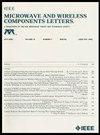Millimeter-Wave Broadband Waveguide-to- Microstrip Transition Using a Bifurcated Probe
IF 3.3
2区 工程技术
Q2 ENGINEERING, ELECTRICAL & ELECTRONIC
引用次数: 2
Abstract
In this letter, a novel waveguide-to-microstrip vertical transition using a bifurcated probe is presented. The bifurcated probe consists of a pair of thin parallel $E$ -plane probes and bend branches, which forms a strong current crowding effect for electromagnetic energy coupling from rectangular waveguide and broadband impendence matching. Therefore, the bifurcated probe can effectively reduce the sensitivity of probe dimensions to transition performance and design difficulty. To demonstrate this concept, a back-to-back bifurcated probe transition operating at WR-4.3 band (170–260 GHz) was fabricated and measured. Measured results show the double transition covers the entire WR-4.3 band with a minimum return loss (RL) of 16 dB and an average insertion loss (IL) of 0.84 dB, respectively.利用分岔探针的毫米波宽频波导-微带转换
在这封信中,提出了一种新的波导到微带的垂直过渡,使用分岔探头。分叉探头由一对细平行的E面探头和弯曲支路组成,对矩形波导的电磁能量耦合和宽带阻抗匹配形成了强电流拥挤效应。因此,分叉探头可以有效降低探头尺寸对过渡性能的敏感性和设计难度。为了证明这一概念,制作并测量了工作在WR-4.3频段(170-260 GHz)的背靠背分叉探针跃迁。测量结果表明,双跃迁覆盖了整个WR-4.3波段,最小回波损耗(RL)为16 dB,平均插入损耗(IL)为0.84 dB。
本文章由计算机程序翻译,如有差异,请以英文原文为准。
求助全文
约1分钟内获得全文
求助全文
来源期刊

IEEE Microwave and Wireless Components Letters
工程技术-工程:电子与电气
自引率
13.30%
发文量
376
审稿时长
3.0 months
期刊介绍:
The IEEE Microwave and Wireless Components Letters (MWCL) publishes four-page papers (3 pages of text + up to 1 page of references) that focus on microwave theory, techniques and applications as they relate to components, devices, circuits, biological effects, and systems involving the generation, modulation, demodulation, control, transmission, and detection of microwave signals. This includes scientific, technical, medical and industrial activities. Microwave theory and techniques relates to electromagnetic waves in the frequency range of a few MHz and a THz; other spectral regions and wave types are included within the scope of the MWCL whenever basic microwave theory and techniques can yield useful results. Generally, this occurs in the theory of wave propagation in structures with dimensions comparable to a wavelength, and in the related techniques for analysis and design.
 求助内容:
求助内容: 应助结果提醒方式:
应助结果提醒方式:


